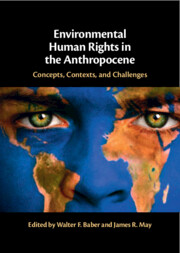Book contents
- Environmental Human Rights in the Anthropocene
- Environmental Human Rights in the Anthropocene
- Copyright page
- Contents
- Contributors
- Acknowledgements
- Introduction
- 1 Framing Environmental Human Rights in the Anthropocene
- 2 Protecting Environmental Human Rights for Future Generations
- 3 Taking Environmental Rights in the Anthropocene Seriously
- 4 The Quest for International Recognition of Environmental Human Rights
- 5 Socioeconomic and Cultural Rights and the Anthropocene
- 6 Local Governments, Climate Action, and Sustainability
- 7 Advancing Environmental Rights through Indigenous Rights
- 8 The Obligation to Curb Carbon Emissions
- 9 Human Rights in the Anthropocene, the Sustainable Development Goals and the Significance of SDG 17, “Partnerships for the Goals”
- 10 The Shape of Environmental Rights Opportunity Structures for the Anthropocene
- Conclusion
- Index
- References
3 - Taking Environmental Rights in the Anthropocene Seriously
The Case of Biodiversity and the Nagoya Protocol
Published online by Cambridge University Press: 02 March 2023
- Environmental Human Rights in the Anthropocene
- Environmental Human Rights in the Anthropocene
- Copyright page
- Contents
- Contributors
- Acknowledgements
- Introduction
- 1 Framing Environmental Human Rights in the Anthropocene
- 2 Protecting Environmental Human Rights for Future Generations
- 3 Taking Environmental Rights in the Anthropocene Seriously
- 4 The Quest for International Recognition of Environmental Human Rights
- 5 Socioeconomic and Cultural Rights and the Anthropocene
- 6 Local Governments, Climate Action, and Sustainability
- 7 Advancing Environmental Rights through Indigenous Rights
- 8 The Obligation to Curb Carbon Emissions
- 9 Human Rights in the Anthropocene, the Sustainable Development Goals and the Significance of SDG 17, “Partnerships for the Goals”
- 10 The Shape of Environmental Rights Opportunity Structures for the Anthropocene
- Conclusion
- Index
- References
Summary
More than fifty years after Christopher Stone (1972) suggested that natural objects should have legal rights, we have seen a rise in the recognition of environmental rights (Boyd, 2012; Sanders, 2018). Whether we call this a wave, trend or “a rights revolution” matters little. There has in any case been a rise in public attention and a wave of academic writings about environmental rights.
- Type
- Chapter
- Information
- Environmental Human Rights in the AnthropoceneConcepts, Contexts, and Challenges, pp. 52 - 69Publisher: Cambridge University PressPrint publication year: 2023



